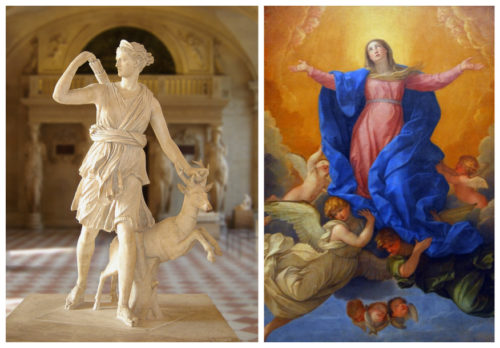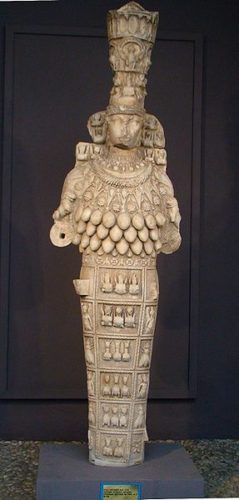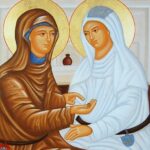Last Updated on August 15, 2024 by Kittredge Cherry

A mid-August holiday was once the festival of the lesbian goddess Diana (Artemis), but it has been adapted into a feast day for the Virgin Mary.
Midsummer feasts have celebrated the divine feminine on Aug. 15 since before the time of Christ. Now devoted to Mary, the holiday known as the Feast of the Assumption (or Dormition) carries the torch of lesbian spiritual power to a new generation on the same date.
Saint Mary, mother of Jesus, is honored by churches on Aug. 15 in a major feast day marking her death and entrance into heaven. Catholic and Orthodox churches call it the Feast of the Assumption or Dormition because they believe that Mary was “assumed” into heaven, body and soul.
The connections between Diana and Mary raise many questions. The concept of virginity has been used to control women, but sometimes it is a code word for lesbian. What shade of meaning is implied by the “virginity” of these two heavenly queens? Did the church patriarchs substitute wild lesbian Artemis with mild straight Mary — or is Mary more versatile and dynamic than many thought?
Mary has assumed much of the status once given to Artemis, but the goddess lives on in pagan communities and popular culture. She is woven into the 2022 lesbian romance novel “Loving Artemis: An Endearing Tale of Revolution, Love and Marriage” by Janet Mason, published by Thorned Heart Press. The coming-of-age story is set in the 1970s and explores the events that led to marriage equality laws.
Ancient Roman festival honored virgin goddess Diana
The Virgin Mary’s holiday was adapted — some would say appropriated — from an ancient Roman festival for Diana, the virgin goddess of the moon and the hunt. Diana, or Artemis in Greek, is sometimes called a lesbian goddess because of her love for woman and her vow never to marry a man. The ancient Roman Festival of Torches (Nemoralia) was held from Aug. 13-15 as Diana’s chief festival.
According to mythology, Diana preferred the company of women and surrounded herself with female companions. They took an oath of virginity and lived as a group in the woods, where they hunted and danced together. Homoerotic art and speculations often focus on Diana’s relationship with the princess Callisto. The god Jupiter (Zeus) lusted after Callisto, so he disguised himself as Diana and seduced Callisto in a woman-to-woman embrace. The lesbian love scene is painted by artists such as Francois Boucher in “Jupiter and Callisto” (below).
 |
| “Jupiter (disguised as Diana) and Callisto” by Francois Boucher (Wikimedia Commons) |
There are many more stories about Diana and the women, nymphs and goddesses whom she loved. The goddess Britomaris was another favorite of Diana. When the lustful king Minos pursued Britomaris, she escaped by leaping into the sea. Diana rescued her and, some say, fell in love with her. Diana also showed love for various princesses. She gave the princess Cyrene a pair of magical dogs and granted the princess Daphne the gift of shooting straight. The princess Atalanta almost died of exposure as a baby girl after her father abandoned her because he wanted a son. Diana saved her and, with the help of a she-bear, Atalanta grew up to become one of Diana’s beloved companions. And this is just the beginning.
Diana’s main holiday was the Festival of Torches or Nemoralia. Hundreds of women and girls carried torches and candles in a night-time procession through the woods. They wore wreaths of flowers — and even put flowers on the hunting dogs who walked with them. The group hiked a few miles from Rome to a sacred site, the circle-shaped Lake Nemi. The dark waters reflected the moon and the torchlight of the pilgrims. There they left offerings of apples, garlic, statues and prayers handwritten on ribbons. Click here for a vivid description of the festival. Ovid, a Roman poet who lived before Christ, described the magic of the festival:
Often does a woman whose prayers Diana answered,
With a wreath of flowers crowning her head,
Walk from Rome carrying a burning torch…
Click here for a beautiful painting of “Diana Asleep in the Woods” by surrealist Giorgio de Chirico. Diana sleeps semi-nude beside an offering of fruit, her bow and arrow, and her large black-and-white spotted dog.
Church incorporates goddess holiday and myths
Aspects of Diana and Artemis were taken over by the church more than 1,300 years ago. The Festival of Torches became the Feast of the Assumption. The Temple of Artemis at Ephesus in Turkey was one of the seven wonders of the ancient world, with an awe-inspiring statue of the “many-breasted” Artemis. The temple was destroyed but the worship of the feminine divine continued in a new form when the Church of Mary, one of the world’s first churches dedicated to the mother of Jesus, was built about a mile away. The Virgin Mary even assumed some titles once given to Artemis, including Queen of Heaven. Legend says that the historical Mary lived in Ephesus with John, the Beloved Disciple.

“Artemis of Ephesus,” 1st century CE Roman copy of the “many breasted” Artemis statue of the Temple of Ephesus (Wikimedia Commons)
Books such as Alone of All Her Sex: The Myth and the Cult of the Virgin Mary by cultural historian Marina Warner show how the figure of Mary was shaped by goddess legends and other historical circumstances, resulting in an inferior status for women. In the novel “Mary and the Goddess of Ephesus: The Continued Life of the Mother of Jesus,” former seminarian Melanie Bacon explores the little-known tradition that after Jesus died, his mother spent most of her adult life in a community dedicated to worshiping Artemis.
Feminists praise Diana/Artemis as an archetype of female power, a triple goddess who represents all phases of womanhood. She is the maiden, wild and free, with no need for a man. She is the “many-breasted” mother who nurtures all life. She is the crone, the mature hunter who provides swift death with her arrows in harmony with the cycles of nature.
LGBTQ people and allies may be inspired by the queer origins of this midsummer holiday. May the Queen of Heaven, by whatever name, continue to bless those who remember her.
Related links:
Black Madonna becomes lesbian defender: Erzuli Dantor and Our Lady of Czestochowa (Jesus in Love)
Queer Lady of Guadalupe: Artists re-imagine an icon (Jesus in Love)
Are there any lesbian goddesseses?
Related books:
“Mother of God Similar to Fire” with icons by William Hart McNichols and reflections by Mirabai Starr presents a wide of variety of liberating icons of Mary, including a black Madonna. McNichols is a New Mexico artist and Catholic priest who has been rebuked by church leaders for making icons of LGBTQ-affirming martyrs and saints not approved by the church.
“Goddess and God in the World: Conversations in Embodied Theology” by Carol P. Christ and Judith Plaskow. Two pioneering leaders in the study of women and religion discuss the nature of God / Goddess.
“Alone of All Her Sex: The Myth and the Cult of the Virgin Mary” by cultural historian Marina Warner shows how the figure of Mary was shaped by goddess legends and other historical circumstances, resulting in an inferior status for women.
“Holiness and the Feminine Spirit: The Art of Janet McKenzie,” edited by Susan Perry, includes many black Madonnas in an art book to nourish devotion to Mary with reflections by diverse women.
___
Top image credits:
Right: “Diana of Versailles,” Roman artwork, Imperial Era (1st-2nd centuries CE). Found in Italy. (Wikimedia Commons)
Left: “Assumption of Mary” by Guido Remi, 1642 (Wikimedia Commons)
___
This post is part of the LGBTQ Saints series by Kittredge Cherry. Traditional and alternative saints, people in the Bible, LGBTQ martyrs, authors, theologians, religious leaders, artists, deities and other figures of special interest to lesbian, gay, bisexual and transgender and queer (LGBTQ) people and our allies are covered.
Editor’s note: This article was originally published at Q Spirit in August 2017, was expanded with new material over time, and was most recently updated on Aug. 14, 2024.
Copyright © Kittredge Cherry. All rights reserved.
Qspirit.net presents the Jesus in Love Blog on LGBTQ spirituality.




















Dont talk about things you dont know. Diana has a male counterpart, he is called Virbius and he is the King of the Forest. Go instruct yourself instead talk nonsense
Being a virgin doesn’t imply lesbianism : it means no sex at all, with anyone. The title “Queen of Heaven” was used for a great many goddesses throughout history but that only undermines any specific link between Artemis and the Virgin Mary, which is nonexistent.
Brilliant and inspirational as always!
She was Perfect.. ARTEMIS! Remember Love Remember Beauty !
REMEMBER.. ANGEL IMMORTAL ✨
RUSLANA
KORSHUNOVA
I am from Italy. I suggest you reading “Beyond god the father” written by Mary Daly. you can find it uploaded on web, too.
mary IS NOT a goddess. She is the servant of the “god the father”. In the bible, mary is not a goddess, she is not a demi-goddess or “so important”. She is only the servant, the slave and the bible does not speak about “her sexual pleasure” with women.
The only god, in christianity, is only jesus christ, male and god. he prays only a god-the-father.
I don’t understand why people persist in mixing worship of the Mother Goddess (modern Wicca religion) with Christianity, a misogynist and patriarchal religion in his idea of god, his idea of “male redeemer”… it’s a religion created by men (males).
In the bible, the homosexuality is condemned (God and saint Paul talk about homosexuality as an abomination)
Perhaps I might add something to the discussion. I am a Catholic. I have been a church organist for 25 years. I started having spiritual experiences a few years back, and they became clearer as time went on. My experiences were of various Greco/Roman gods, but the main deitical figure has been Artemis. Over and over again, Artemis has shown herself through synchronicity. I have not had any experiences of the Virgin Mary. Not sure where that leaves me really. I don’t know if it’s a good or a bad thing or whether I should remain in the Catholic Church. All I know is that Artemis is very real with real power over nature and the elements. No wonder she was invoked in war.
Kudos to you Luna couldn’t have said it better myself.
Check out the “Temple Theology” work of Margaret Barker (margaretbarker.com)– in this case, particularly, her book “The Lady in the Temple”. Roots of the cult of Mary may go back to the original Jerusalem Temple cult in which Asherah was venerated as “the Queen of Heaven” (before the purge under King Josiah). It might be that Jesus the Nazorean was part of a Jewish movement yearning to restore the original temple worship, bringing back Asherah (in opposition to the existing temple establishment, which was Herodian or pro-Rome). Goddess cults tended to have a place for homosexuality while male-monotheism did not.
Fascinating! I will check into your tip about how Jesus may have wanted to restore goddess worship of the “Queen of Heaven” in Jerusalem.
why would a divine ever mingle with people`s private life, not a whole lot of love, that would be…